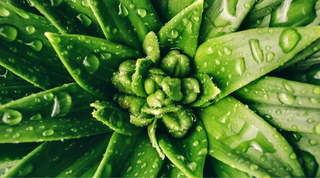Introduction
If you’ve ever had a sunburn, breakout, or itchy patch of skin, chances are someone told you to try aloe vera. But in 2025, there’s a new plant in the skincare spotlight: CBD. Both are natural. Both are soothing. So… which one’s better? In this breakdown, we’ll dive deep into the benefits of CBD vs aloe vera, how they work, when to use each — and whether combining them is the ultimate skin win.
What Is CBD and How Does It Work?
CBD (short for cannabidiol) is a non-intoxicating compound derived from hemp that’s known for its anti-inflammatory and skin-calming properties. It interacts with the body’s endocannabinoid system (ECS), which regulates functions like pain, inflammation, and even sebum production. Applied topically, CBD taps into receptors in the skin to reduce redness, soothe irritation, and support skin recovery.
Research suggests CBD can also act as an antioxidant and antimicrobial agent, making it ideal for inflamed or acne-prone skin. People use it for everything from post-workout soreness to calming eczema flare-ups. And the best part? It won’t get you high and is generally well-tolerated by all skin types.
CBD skincare is now a staple for wellness-focused consumers who want plant-powered results without synthetic additives. Look for products that are lab-tested and made with clean ingredients — that’s where CBD really shines.
 What Is Aloe Vera and How Does It Work?
What Is Aloe Vera and How Does It Work?
Aloe vera has been a go-to home remedy for generations. Sourced from the inner gel of the aloe plant, it’s rich in vitamins (like A, C, and E), enzymes, and a whole lot of water. That’s why it feels instantly cooling on sunburns and dry, irritated skin.
The gel acts as a humectant — pulling moisture into the skin — and helps create a protective barrier that supports healing. It’s especially helpful for surface-level burns, rashes, and minor cuts. However, while aloe is amazing for hydration and soothing, its effects don’t usually penetrate deeper layers of inflammation.
It’s a skincare hero for quick, surface-level relief — but when it comes to more intense concerns like deep irritation, joint pain, or chronic inflammation, it may need some backup. Enter: CBD.
CBD vs Aloe Vera: Head-to-Head Comparison
Let’s break it down. When it comes to inflammation relief, CBD often wins — it works below the skin’s surface, making it ideal for soreness, acne, and chronic flare-ups. Aloe, while soothing, typically provides more temporary surface-level comfort.
Hydration? Aloe is the MVP here, thanks to its high water content. But CBD can also support moisture retention when paired with hydrating ingredients like shea butter or jojoba oil.
For skin repair and regeneration, both offer benefits. CBD helps reduce oxidative stress and balance skin function, while aloe supports wound healing and skin elasticity.
When managing pain and discomfort, CBD is known to reduce nerve sensitivity and muscle tension. Aloe is gentler — more of a refreshing cooldown than a deep therapeutic experience.
And how long do the effects last? CBD’s anti-inflammatory effects can last several hours, while aloe offers quicker, shorter-term relief. Together? They bring out the best in each other.
Can You Use CBD and Aloe Vera Together?
Absolutely — and it’s a hot trend in 2025. CBD and aloe are the dream team of plant-based skincare: aloe gives instant surface relief and hydration, while CBD dives deeper to tackle inflammation and discomfort.
Using them together can amplify results. Aloe cools the skin and preps it for better absorption, while CBD targets deeper concerns like joint pain or eczema. That’s why many brands, including hhemp.co, are developing multifunctional balms and topicals that blend both ingredients into one seamless solution.
Wondering whether to layer or blend? If you’re DIYing, layer aloe first to hydrate, then apply your CBD balm or oil. But if you want maximum impact with zero guesswork, go for blended products designed with this synergy in mind.
When to Choose CBD, Aloe, or Both
Got sunburn? Start with aloe for instant cooling, then layer on CBD to reduce long-term inflammation and support healing.
Dealing with acne or sensitive skin? CBD’s anti-inflammatory and oil-balancing powers are key. Aloe can help reduce irritation from breakouts or redness.
Need help with sore muscles or injuries? CBD wins here — it can reduce tension, ease nerve pain, and promote faster recovery. Aloe may feel nice but won’t do the heavy lifting.
For daily skincare, especially for moisture and prevention, using both can be a gentle, effective combo. Look for hybrid products with clean, skin-nourishing ingredients.
Choosing the Right Products for Your Skin
Not all CBD and aloe products are created equal. When shopping for CBD skincare, look for:
- Clearly labeled CBD potency (in mg)
- Full or broad-spectrum hemp extract
- Clean, plant-based ingredients
- Lab testing results for safety and purity
With aloe vera, watch for high percentages of pure aloe gel and minimal additives or fillers — some store brands water it down or add alcohols that can dry the skin.
Product spotlight: hhemp.co’s multifunctional soothing balm combines full-spectrum CBD with aloe, shea butter, and botanical oils to target both surface irritation and deep discomfort. Bonus: it’s made with transparency, clean ingredients, and real science.
Conclusion
When it comes to CBD vs aloe vera, you don’t always have to choose. Aloe is amazing for surface-level soothing, while CBD brings deeper inflammation relief and skin-balancing benefits. Together? They’re a skincare power couple. For next-level calm, browse hhemp.co’s plant-powered products and find the blend that works best for you. Your skin will thank you.





